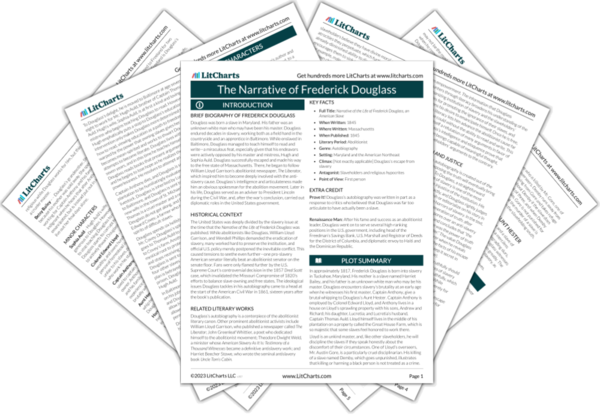Summary
Analysis
Douglass was born in Tuckahoe, Maryland. Like most slaves, he does not know when he was born, because masters usually try to keep their slaves from knowing their own ages.
From the outset of the book, Douglass makes it clear that slaves are deprived of characteristics that humanize them, like birthdays.
Themes
Quiz
Test Yourself
Douglass’s mother is named Harriet Bailey, and his father is an unknown white man rumored to be Douglass’s own master. When Douglass was only an infant, he was separated from his mother, as is commonly done to destroy the bond enslaved children feel towards their mothers. Douglass was only able to see his mother four or five times, when she journeyed over from her plantation to his and spent the night with him. When Douglass is only about seven years old, his mother dies, and he reacted to “the tidings of her death with much the same emotions [he] should have probably felt at the death of a stranger.”
Douglass and his mother are further dehumanized by being unable to cultivate one of the most fundamental human relationships: the bond between mother and child. By reducing this relationship, slaveholders are better able to dictate their slaves’ emotions and to ensure that strong family emotions don't interfere with slaves following their master's commands.
Themes
Quiz
Test Yourself
Because of his separation from his mother, and her untimely death, Douglass has no idea who his father is. Ultimately, this fact makes little difference, since slaveholders have prescribed that children of mixed parentage always follow the status of their mothers. This allows slave owners to take advantage of their female slaves sexually without reducing their workforce. The mixed-race “mulatto” offspring are frequently abused because the slave owner’s white family resents their existence. To avoid these tensions, a master will often sell his own children to a trader.
Slavery is detrimental not only to the enslaved, but also to the enslaver: the system for “inheriting” enslavement is designed to cater to the greedy, sexual impulses of male slaveholders. Worse yet, slavery distorts the bond between father and son, as fathers frequently own their own children and, further, sell their children to other slave owners.
Themes
Quiz
Test Yourself
If this mulatto population keeps growing, Douglass observes that slavery will no longer be able to persist under its so-called biblical justification, which states that all descendants of Ham are cursed and deserve enslavement.
By pushing the logical limits of slavery’s allegedly biblical rationalization (that blacks are the descendants of Ham, a cursed son of Noah), Douglass underscores the dubiousness of the grounds used to justify slavery.
Themes
Literary Devices
Quiz
Test Yourself
Get the entire Narrative of Frederick... LitChart as a printable PDF.

Douglass has had two masters. The first was a sailor from the Chesapeake named Captain Anthony. Anthony was not a rich slaveholder, and only owned thirty slaves for his handful of farms. Anthony was a barbarous slave owner, and had a still more barbarous overseer named Plummer. Douglass cannot forget witnessing Anthony brutally whip one of Douglass’s aunts, Hester. Seeing the master draw blood and screams until he is too tired to continue is, to Douglass, “the first of a long series of such outrages, of which I was doomed to be a witness and a participant.” In other words, this is Douglass’s first encounter with the abominable nature of slavery. He cannot describe the horror it evoked in him, writing only that “I wish I could commit to paper the feelings with which I beheld it.”
As he matures, Douglass gradually begins to comprehend the scope of the injustice perpetuated by slavery. His first encounter with the brutality of slavery was obviously deeply traumatic—the horror he felt when he witnessed Hester’s whipping is too great for him to convey to a reader.
Themes
Quiz
Test Yourself
Aunt Hester was being whipped by Anthony for spending time with a slave from a nearby plantation, named Ned. Douglass remembers that Hester was very attractive. Anthony seems to be jealous of her spending time with men, and calls her a string of misogynistic names as he whips her.
Anthony’s violence is grounded in nothing more than petty jealousy and sexual desire, and his punishment of Hester, like many slaveholders’ actions, borders on hypocritical.
Themes
Literary Devices
Quiz
Test Yourself
Fearful that he may be next, the young Douglass hides in a closet after witnessing the whipping. This was his first real glimpse of the horror of slavery, as he lived with his grandmother on the outskirts of the plantation.
When he sees Hester whipped, the young Douglass’s illusions of happiness are quickly destroyed, and his future suffering is foreshadowed.
Themes
Literary Devices
Quiz
Test Yourself












